
Carlo Fea was an Italian archaeologist.
The Salimbeni Prize is awarded by the Fondazione Salimbeni per le Arti Figurative of San Severino Marche to honour excellence in the writing of art history on an Italian subject. The Premio Salimbeni was established in 1983.
Domenico de' Rossi (1659–1730) was an Italian sculptor and engraver.

As the home of the Pope and the Catholic curia, as well as the locus of many sites and relics of veneration related to apostles, saints and Christian martyrs, Rome had long been a destination for pilgrims. The Via Francigena was an ancient pilgrim route between England and Rome. It was customary to end the pilgrimage with a visit to the tombs of Sts Peter and Paul. Periodically, some were moved to travel to Rome for the spiritual benefits accrued during a Jubilee. These indulgences sometimes required a visit to a specific church or churches. Pilgrims need not visit each church.
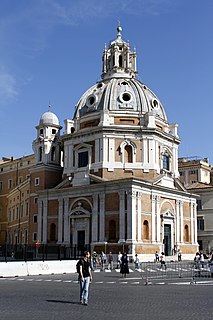
Santa Maria di Loreto is a 16th-century church in Rome, central Italy, located just across the street from the Trajan's Column, near the giant Monument of Vittorio Emanuele II.

Giovanni Andrea Lazzarini was an Italian painter, poet, and art historian of the late-Baroque or Rococo.
Giuseppe Sardi was an Italian architect active in Rome. He was born at Sant'Angelo in Vado, Marche which was then part of the Papal States. Known primarily for his church of Santa Maria del Rosario in Marino outside Rome, his name has been linked with the design of the façade of the church of Santa Maria Maddalena in Rome although his involvement with this and with some other building projects remains uncertain. He is not to be confused with the Swiss Italian architect, Giuseppe Sardi (1624–1699), who was active in Venice.

The Church of Saint Athanasius, also known as Sant'Atanasio dei Greci, is a Greek Catholic titular church located on Via del Babuino 149, near the Spanish steps, in the rione Campo Marzio of Rome, Italy.
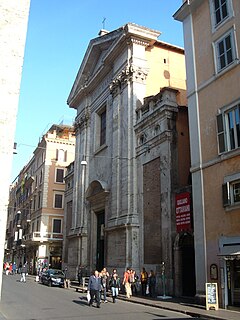
Gesù e Maria is a Baroque church located on Via del Corso in the Rione Campo Marzio of central Rome, Italy. It faces across the street the similarly Baroque facade of San Giacomo in Augusta.
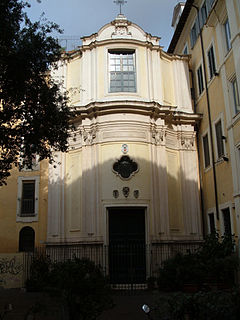
Santa Maria della Quercia is a Roman Catholic church located on the piazza of the same name, one block southeast of the Palazzo Farnese in the Rione (district) of Regola of central Rome, Italy.

Santi Celso e Giuliano is a minor basilica church in Rome, Italy. It has held this status by custom and practice since ancient times. The church is located on Vicolo del Curato number 12, just off Via del Banco di Santo Spirito, the road leading to Ponte Sant'Angelo.
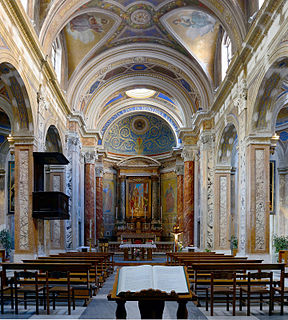
Santa Maria in Monticelli is a church in the rione of Regola in Rome, sited on the street of the same name.

Santa Maria della Concezione is a church in Rome, located on Piazza Campo Marzio in the Campo Marzio rione.

Santo Stanislao dei Polacchi, also known as San Stanislao alle Botteghe Oscure, is a Roman Catholic church in Rome, sited on Via delle Botteghe Oscure in the Sant'Angelo rione. It is the national church of Poland in Rome.
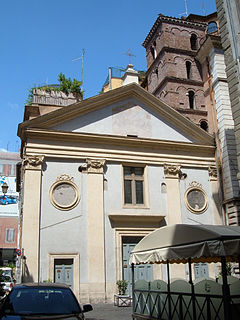
San Salvatore alle Coppelle is a church in Rome, on piazza delle Coppelle in the Sant'Eustachio district.
Matteo Pannaria or Panaria or Pannerio was an Italian painter of the late-Baroque. He was born in Palermo, Sicily and active both in Rome and Jesi. He painted a Glory of San Giovanni Nepomuceno (1753) for the church of San Giovanni Battista in Jesi. He frescoed the ovals in the ceiling of the church of Santi Quaranta Martiri in Rome. He also painted Beato Giovanni of Prado in one of the chapels.
Cristoforo Ambrogini was an Italian painter active in Rome in the late 16th - early 17th century. His only known works are the frescoes on the facade of the church of San Giacomo Scossacavalli in Rome, and those on the walls and the vault of the first chapel of the right nave in the same church. The chapel was restructured in 1600 by architect Antonio Longhi and was thereafter decorated by Ambrogini. San Giacomo was destroyed in 1937 for the erection of Via della Conciliazione.

Santa Maria in Monterone is a Roman Catholic church in Rome, Italy. Its suffix originates from the Sienese Monteroni family, whose patronage rebuilt the church and built a small hospice next to it for pilgrims from Siena. It is located on Via Santa Maria in Monterone in the Sant'Eustachio rione. Next to the church is a Redemptorist monastery, whose clergy manage the church.

Madonna and Child with Four Doctors of the Church is a 1540-1545 oil on canvas painting by Moretto da Brescia, now in the Städelsches Kunstinstitut in Frankfurt. From left to right it shows Saint Ambrose, Gregory the Great, Saint Jerome and Augustine of Hippo.
Maria Eufrasia della Croce (1597–1676) was a nun and artist. She was born Flavia Benedetti in Rome; she became a nun in 1628 and painted many works for her Roman convent of S. Giuseppe a Capo le Case of the Discalced Carmelites. Her father was a Roman patrician and she had three brothers, one a Capuchin monk, and one, the Abbott Elpidio, secretary to Cardinal Mazarin, who also collected art and was an amateur architect.













